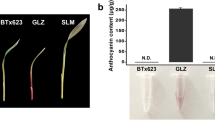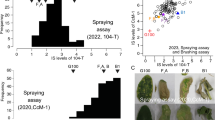Abstract
Polymorphisms at the Waxy locus of Amaranthus caudatus L. collected from a wide range of regions were used to investigate genetic diversity and mutation sites. A comparison of the Waxy locus revealed a very high level of sequence conservation. This result clearly showed low environmental and evolutionary variability in the Waxy gene. We also performed screening to confirm the mutation sites in the coding sequences of all accessions. The results indicate that one insertion in the coding region of Waxy genes was responsible for the change in perisperm starch leading to the waxy phenotype in all accessions of this species, and thus that a single mutation event altered the regulation of the Waxy gene during the domestication of this crop. In addition, phylogenetic analysis showed that waxy phenotypes within each of three species, A. caudatus, A. cruentus and A. hypochondriacus, originated separately or differentiated from nonwaxy phenotypes of each species through a single mutational event (i.e., a frame shift or base substitution). We also compared obvious structural features of the coding sequence of waxy and nonwaxy phenotypes with those of low-amylose phenotypes in A. caudatus. The Waxy coding sequences of low-amylose phenotypes do not show polymorphisms and are identical with those of waxy phenotypes. This could mean that there is another gene that encodes a key enzyme responsible for amylose synthesis as the elementary quantity in tissues other than perisperm in A. caudatus.



Similar content being viewed by others

References
Cai X, Wang Z, Xing Y, Zhang J, Hong M (1998) Aberrant splicing of intron 1 leads to the heterogeneous 5′UTR and decreased expression of waxy gene in rice cultivars of intermediate amylose content. Plant J 14:459–465
Clark J, Robertson M, Ainsworth C (1991) Nucleotide sequence of a wheat (Triticum aestivum L.) cDNA clone encoding the waxy protein. Plant Mol Biol 16:1099–1101
Denyer K, Barber LM, Burton R, Hedley CL, Hylton CM, Johnson S, Jones DA, Marshall J, Smith AM, Tatge H et al (1995) The isolation and characterization of novel low-amylose mutants of Pisum sativum L. Plant Cell Environ 18:1019–1026
Denyer K, Barber LM, Edward EA, Smith AM, Wang TL (1997) Two isoforms of the GBSSI class of granule-bound starch synthase are differentially expressed in the pea plant (Pisum sativum L.). Plant Cell Environ 20:1566–1572
Domon E, Saito A, Takeda K (2002) Comparison of the waxy locus sequence from a non-waxy strain and two waxy mutants of spontaneous and artificial origins in barley. Genes Genet Syst 77:351–359
Fedoroff N, Wessler S, Shure M (1983) Isolation of the transposable maize controlling elements Ac and Ds. Cell 35:235–242
Felsenstein J (1985) Confidence limits on phylogenies: an approach using the bootstrap. Evolution 39:783–790
Fukunaga K, Kawase M, Kato K (2002) Structural variation in the Waxy gene and differentiation in foxtail millet [Setaria italica (L.) P. Beauv.]: implications for multiple origins of the waxy phenotype. Mol Genet Genomics 268:214–222
Hirano HY, Eiguchi M, Sano Y (1998) A single base change altered the regulation of the waxy gene at the posttranscriptional level during the domestication of rice. Mol Biol Evol 15:978–987
Hunt HV, Denyer K, Packman LC, Jones MK, Howe CJ (2010) Molecular basis of the waxy endosperm starch phenotype in broomcorn millet (Panicum miliaceum). Mol Biol Evol 27:1478–1494
Kawase M, Fukunaga K, Kato K (2005) Diverse origins of waxy foxtail millet crops in East and Southeast Asia mediated by multiple transposable element insertions. Mol Genet Genomics 274:131–140
Kimura T, Ideta O, Saito A (2000) Identification of the gene encoding granule-bound starch synthase I in sweet potato (Ipomoea batatas (L.) Lam.). Plant Biotechnol 17:247–252
Klösgen R, Gierl A, Schwarz-Sommer Z, Saedler H (1986) Molecular analysis of the waxy locus of Zea mays. Mol Genet Genomics 203:237–244
Konishi Y, Nojima H, Okuno K, Asaoka M, Fuwa H (1985) Characterization of starch granules from waxy, nonwaxy, and hybrid seeds of Amaranthus hypochondriacus L. Agri Biol Chem 49:1965–1971
Martin C, Smith A (1995) Starch biosynthesis. Plant cell 7:971–985
Murai J, Taira T, Ohta D (1999) Isolation and characterization of the three Waxy genes encoding the granule-bound starch synthase in hexaploid wheat. Gene 234:71–79
Murray M, Thompson W (1980) Rapid isolation of high molecular weight plant DNA. Nucl Acids Res 8:4321
Okagaki R (1992) Nucleotide sequence of a long cDNA from the rice waxy gene. Plant Mol Biol 19:513–516
Okuno K, Sakaguchi S (1981) Glutinous and non-glutinous starches in perisperm of grain amaranths. Cereal Res Commun 9:305–310
Park YJ, Nemoto K, Nishikawa T, Matsushima K, Minami M, Kawase M (2009) Molecular cloning and characterization of granule bound starch synthase I cDNA from a grain amaranth (Amaranthus cruentus L.). Breed Sci 59:351–360
Park YJ, Nemoto K, Nishikawa T, Matsushima K, Minami M, Kawase M (2010a) Waxy strains of three amaranth grains raised by different mutations in the coding region. Mol Breed 25:623–635
Park YJ, Nemoto K, Nishikawa T, Matsushima K, Minami M, Kawase M (2010b) Origin and evolution of the waxy phenotype in Amaranthus hypochondriacus: evidence from the genetic diversity in the Waxy locus. Mol Breed. doi:10.1007/s11032-010-9533-y
Park YJ, Nemoto K, Nishikawa T, Matsushima K, Minami M, Kawase M (2011) Genetic diversity and expression analysis of granule bound starch synthase I gene in the new world grain amaranth (Amaranthus cruentus L.). J Cereal Sci 53:298–305
Rohde W, Becker D, Salamini F (1988) Structural analysis of the waxy locus from Hordeum vulgare. Nucl Acids Res 16:7185
Sauer JD (1950) The grain amaranths: a survey of their history and classification. Ann Missouri Bot Gard 37:561–619
Sauer JD (1967) The grain amaranths and their relatives: a revised taxonomic and geographic survey. Ann Missouri Bot Gard 54:103–137
Smith AM, Denyer K, Martin C (1997) The synthesis of the starch granule. Annu Rev Plant Biol 48:67–87
Swofford D (1998) PAUP*: phylogenetic analysis using parsimony and other methods, version 4.0 (test ver. 61–64). Sinauer Associates Publishers, Sunderland
Thompson J, Gibson T, Plewniak F, Jeanmougin F, Higgins D (1997) The CLUSTAL_X windows interface: flexible strategies for multiple sequence alignment aided by quality analysis tools. Nucl Acids Res 25:4876
van der Leij F, Visser R, Ponstein A, Jacobsen E, Feenstra W (1991) Sequence of the structural gene for granule-bound starch synthase of potato (Solanum tuberosum L.) and evidence for a single point deletion in the amf allele. Mol Gen Genet 228:240–248
Vrinten P, Nakamura T, Yamamori M (1999) Molecular characterization of waxy mutations in wheat. Mol Genet Genomics 261:463–471
Wang Z, Zheng F, Shen G, Gao J, Snustad D, Li M, Zhang J, Hong M (1995) The amylose content in rice endosperm is related to the post-transcriptional regulation of the waxy gene. Plant J 7:613–622
Wessler S, Varagona M (1985) Molecular basis of mutations at the waxy locus of maize: correlation with the fine structure genetic map. Proc Natl Acad Sci USA 82:4177–4181
Acknowledgments
We express our sincere thanks to Dr. D. Brenner of USDA-ARS-MWA-PIRU, Iowa State University, USA, for providing the accessions used in this experiment. We also would like to thank Ms. Sachiko Ohashi for expert technical assistance. This research was supported by the grant-in-aid for Japan Society for the Promotion of Science (JSPS) fellows relating to JSPS Postdoctoral Fellowship for Foreign Researchers (ID No. P 11212).
Author information
Authors and Affiliations
Corresponding author
Electronic supplementary material
Below is the link to the electronic supplementary material.
Rights and permissions
About this article
Cite this article
Park, YJ., Nishikawa, T., Tomooka, N. et al. The molecular basis of mutations at the Waxy locus from Amaranthus caudatus L.: evolution of the waxy phenotype in three species of grain amaranth. Mol Breeding 30, 511–520 (2012). https://doi.org/10.1007/s11032-011-9640-4
Received:
Accepted:
Published:
Issue Date:
DOI: https://doi.org/10.1007/s11032-011-9640-4



